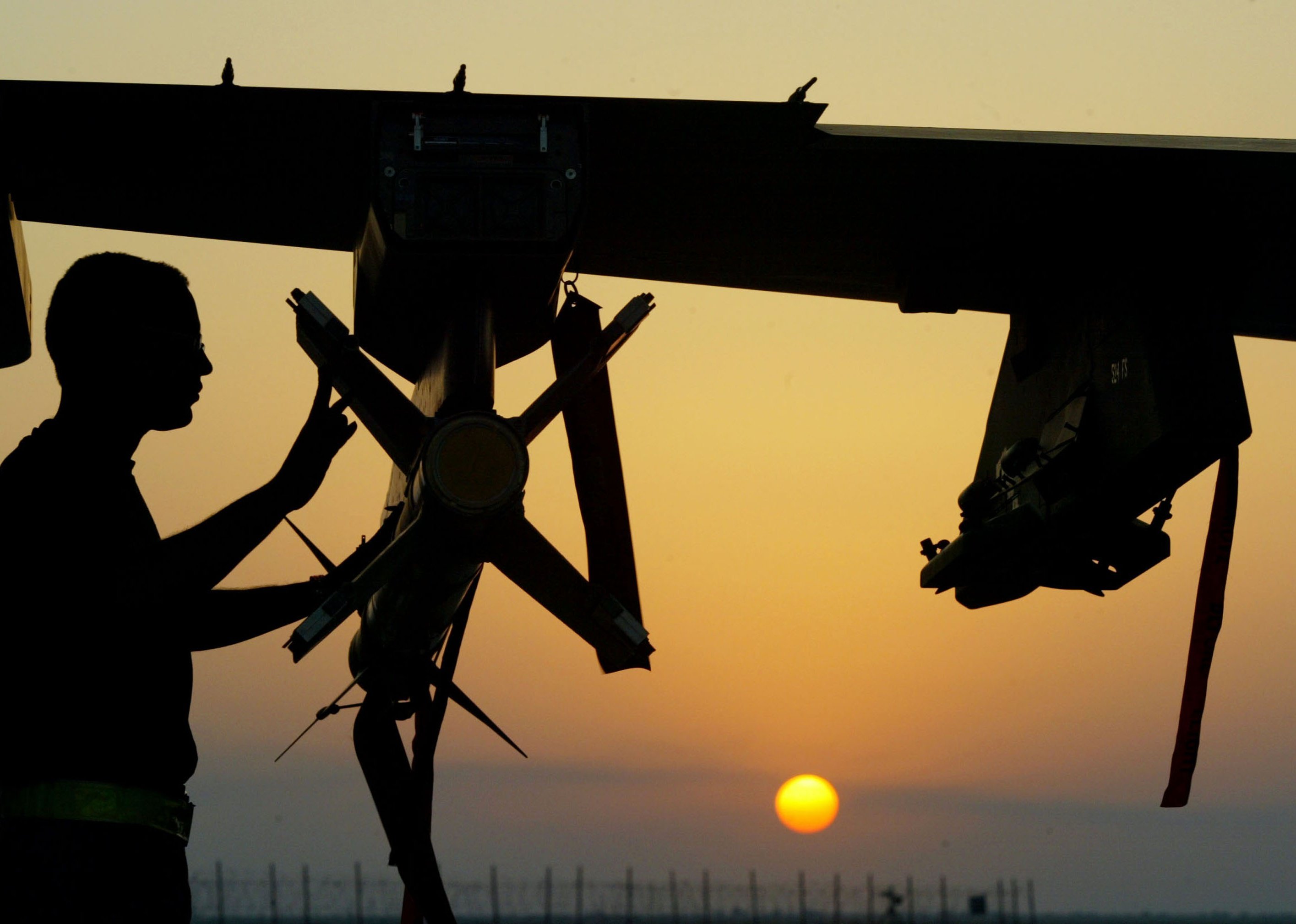Peter Turnley // Getty Images The Gulf War–also called the Persian Gulf War–was a crisis that affected the world for years after it ended. The Gulf War was one of the shortest wars that the U.S. has engaged in, dating from August 1990 to February 1991. Initiated by Iraqi President Saddam Hussein, the Gulf War was the first crucial international conflict the U.S. faced after the Cold War. The crisis stemmed from a growing tension between two countries–Iraq and Kuwait. Following the end of the Iran-Iraq war in 1988, Iraq had accumulated an enormous amount of debt, including to Kuwait, which it owed several billion dollars. Saddam Hussein thought that this debt should be canceled, and considered the price of Iraq’s protection of the Arabian Peninsula against Iran. However, Kuwait and the United Arab Emirates refused to cancel the debt, leading Saddam to begin threatening attacks, which eventually turned into a full-scale war. During the Gulf War, the U.S. deployed high-tech military equipment that had never been used before. Cruise missiles and Stealth bombers were among the new weapons used to fight the war. The Global Positioning System (GPS) was also introduced, significantly improving the military’s land navigation. It was the first time that a major U.S. military mission extensively used resources in space, leading Operation Desert Storm to be dubbed “the first space war.” Though short in duration, the Gulf War produced lasting consequences for both the military troops involved and the world at large. Areas such as the “Highway of Death” symbolized the brutal reality of the war, with American aircraft destroying hundreds of vehicles, killing their uncounted occupants. There are differing reports on the number of Iraqi troops who went to war and the number of those who died. Estimates of participating Iraqi soldiers in the Kuwait theatre range from 180,000 to 630,000. Death estimates range from 8,000 to 50,000 Iraqi troops killed. It is nevertheless clear that Iraq suffered many more deaths than the Allied forces did. It is reported that about 697,000 U.S. soldiers went to war, with 299 deaths. Surviving troops suffered, too, though. After the war ended, soldiers began reporting mysterious, unexplained medical ailments. Now known as Gulf War Illness or Gulf War Syndrome, this illness includes symptoms such as fatigue, headaches, insomnia, joint pain, and other maladies. Years later, veterans continue to be plagued by these odd symptoms. Experiences of the war also haunt veterans, resulting in post-traumatic stress disorder (PTSD) for many of them. The war took a toll on the planet as well. As Iraqi troops retreated from Kuwait, they set more than 700 oil wells on fire and left multiple pools of oil. This resulted in an environmental catastrophe. About 300 oil lakes eventually sat on the desert surface, contaminating the soil. Crude oil flowed into the Persian Gulf. Fires burned for 10 months, creating thick clouds of smoke. While the fires were eventually put out, the repercussions of the environmental crisis still remain even today. Also, the end of the Gulf War in 1991 did not mean the end of disputes with Iraq. The U.S. continued to have conflicts with Iraq in the following years, which eventually led to the beginning of the Iraq War in 2003. Using multiple sources, Stacker created a timeline of the Gulf War. Keep reading to learn more history about this brief but important war. July 1990: Iraqi President Saddam Hussein accuses and threatens Kuwait Jacques Pavlovsky // Getty Images Along with his debt-cancellation demands, Saddam Hussein accused Kuwait and the United Arab Emirates of surpassing the maximum oil export levels set by the Organization of Petroleum Exporting Countries (OPEC). He also accused Kuwait–a major oil producer–of stealing oil from the Rumaila oil field, which is located on the Iraq-Kuwait border. With Saddam threatening military action, Egyptian President Hosni Mubarak arranged negotiations between the two countries–but the meetings fell apart. Aug. 2, 1990: Iraq attacks Kuwait Pool BASSIGNAC/SAUSSIER // Getty Images During the negotiations, Iraqi troops had begun lining up on the border of Kuwait. Then, on Aug. 2, 1990, Iraqi troops infiltrated Kuwait, overtaking its capital city within hours. Though Kuwait’s smaller army was able to fight back briefly, Iraq’s robust army–the fourth-largest in the world at the time–easily seized the country. Aug. 5, 1990: President George H.W. Bush condemns Iraq invasion White House via CNP // Getty Images On Aug. 5, 1990, U.S. President George H.W. Bush delivered a memorable response to the crisis, rebuking Iraq’s invasion of Kuwait. Bush proclaimed, “This will not stand, this aggression against Kuwait.” Aug. 6, 1990: Saudi Arabia’s King Fahd asks for military assistance Allan Tannenbaum // Getty Images On Aug. 6, 1990, King Fahd of Saudi Arabia met with U.S. Secretary of Defense Dick Cheney and requested military aid from the U.S. to protect Saudi Arabia from possible Iraqi attacks. The U.S. launched Operation Desert Shield–a military buildup that assembled troops from many nations to defend Saudi Arabia. Like Kuwait, Saudi Arabia was heavily oil-rich, and if Iraq gained control of the country, Saddam would have control of a large share of the world’s oil supply. Aug. 8, 1990: First US Air Force fighter planes arrive in Saudi Arabia GERARD FOUET // Getty Images On Aug. 8, 1990, the U.S. Air Force arrived in Saudi Arabia as part of Operation Desert Shield. On this day, Iraq also formally annexed Kuwait. Subsequently, in late August, Saddam announced that Kuwait was Iraq’s 19th province. Aug. 9, 1990: UN Security Council passes Resolution 662 Eric BOUVET/Gamma-Rapho // Getty Images On Aug. 9, 1990, the U.N. Security Council issued Resolution 662. This action proclaimed that Iraq’s annexation of Kuwait was legally invalid, null, and void. October 1990: Bush increases US forces Tom Stoddart // Getty Images In October 1990, offensive plans were discussed, and war plans were presented to President Bush. Subsequently, the president decided to double U.S. forces in Saudi Arabia. Nov. 29, 1990: UN Security Council permits the use of force against Iraq Tom Stoddart // Getty Images On Nov. 29, 1990, the U.N. Security Council passed Resolution 678. This action authorized the use of “all necessary means” to force Iraqi troops out of Kuwait if they did not leave by Jan. 15, 1991. Jan. 9, 1991: US Secretary of State James Baker meets with Iraqi Foreign Minister Tariq Aziz
A timeline of the Gulf War















